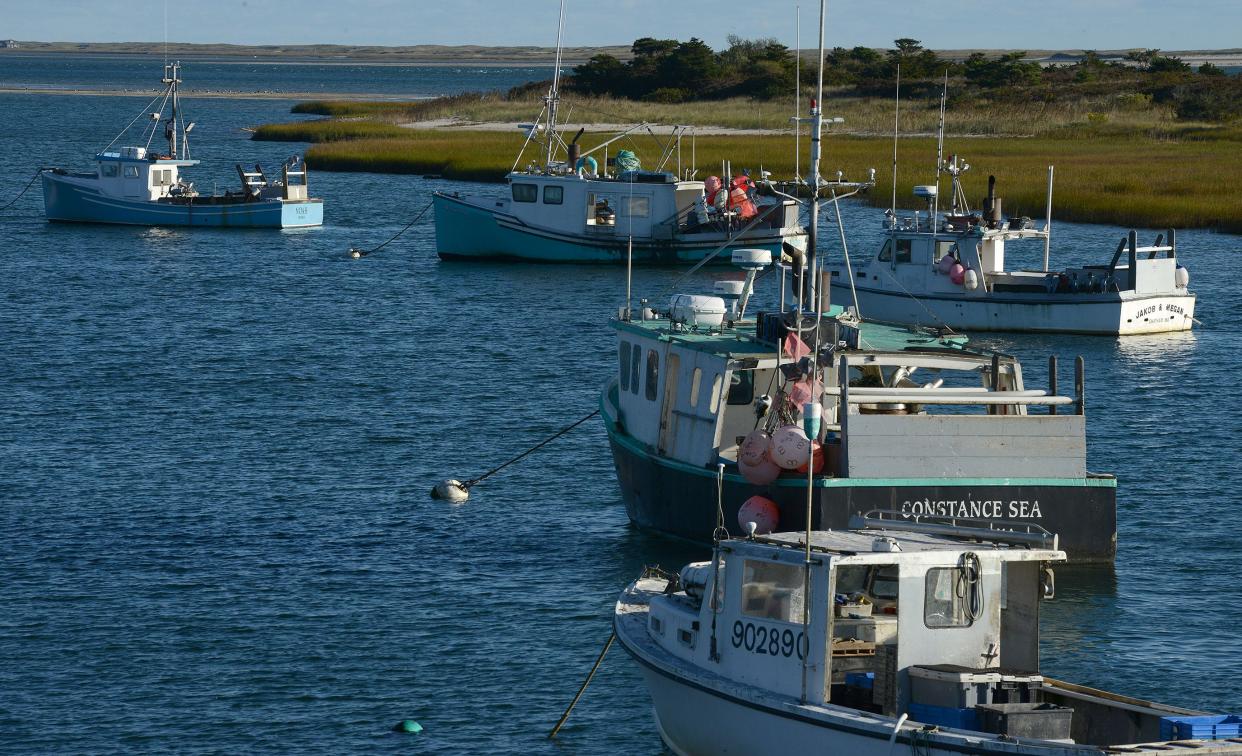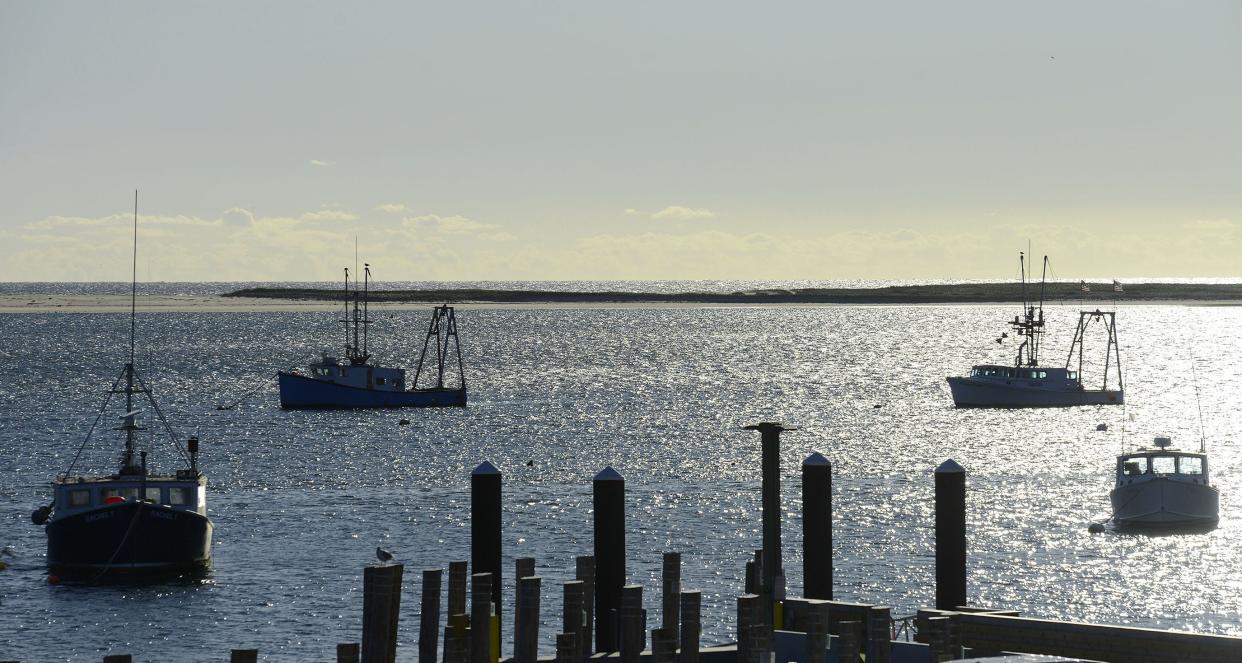'Until the last fish is gone.' Cape Cod fishers worry trawling is depleting sea herring.
A little silver fish — the Atlantic sea herring — is causing a ruckus in New England fishery management circles. That's because the population has shrunk dramatically.
A number of the Cape's small boat fishermen, whale watch captains, and fishing charter operators blame midwater trawlers for depletion of herring stock. That depletion, they claim, has had a negative economic impact on their businesses.
Midwater trawlers are impressive. They can catch and hold a million pounds of herring at a time. They are used for other fish as well, including mackerel, another important forage fish in Cape waters.
Two of the big boats are based out of Cape Seafood's Gloucester dock: the 40-foot-wide, 140-foot-long F/V Endeavor, which can hold 450 metric tons of fish, and its sister ship, the F/V Challenger. Pickup trucks and industrial fork lifts are dwarfed next to the Challenger in a photo of the vessel on a 900-ton boat hoist at Goodison Shipyard in Rhode Island. Cape Seafoods President Gerry O'Neill declined to comment for this story.

When midwater trawler crews spot schools of herring, they drop a large, cone-shaped net overboard and haul it through the water. Sometimes trawlers pair up and tow a big net between them. Ray Kane, outreach coordinator with the Cape Cod Commercial Fishermen’s Alliance, said that between the "football-field" size of the nets and the speed of the trawlers, the fishing method is too efficient for local waters. Eric Hesse, captain of the fishing vessel Tenacious II homeported in Harwich Port, calls it a destructive, take-no-prisoners way of fishing.
“We’ve seen these huge boats just pounding an area until the last fish is gone,” Hesse said.
Strategies to conserve, rebuild the herring fishery
On Sept 28, after an hour of discussion and disagreement over how to help the species rebound, the New England Fishery Management Council voted to start work on a regulation amendment that would keep midwater trawlers farther offshore than is currently allowed.
The council is responsible for conservation and management of fishery resources from three to 200 miles off the coasts of Maine, New Hampshire, Massachusetts, Rhode Island, and Connecticut. Their vote —12 to 2, with two abstentions — sets in motion a lengthy process that could ultimately push the trawlers 20 miles out from Cape shores.
John Pappalardo, CEO of the Cape Cod Commercial Fishermen’s Alliance, has worked for decades to do just that. He believes midwater trawlers are a big reason for the herring’s population decline.
Herring stock has declined significantly
All parties at the September council meeting agreed that the herring stock is down considerably. But there is strong disagreement as to why. Climate change, warming waters, and the migratory nature of the herring have all been suggested as reasons. All parties point to the economic impact of the herring fishery on their businesses.

Between 2014 and 2021, U.S. catch levels plummeted from 93,000 metric tons to 5,000 metric tons, Janice Plante, the council’s spokesperson, said in an interview Oct. 4.
In 2022, commercial landings of Atlantic herring totaled about 9.4 million pounds — 1 metric ton is equal to 2,205 pounds — and were valued at $4.5 million, according to the National Oceanic and Atmospheric Administration. They are sold frozen, salted, and canned as sardines. They are also bait for fishermen targeting lobster and other species.
The National Oceanic and Atmospheric Administration has proclaimed herring “overfished” and their populations below target limits. The biomass of herring in the management areas off the coast of Massachusetts and Cape Cod used to be enormous, according to Plante. But "recruitment" — the process during which small fish grow into big fish — and catch levels have been terrible in recent years.
Why do herring matter?
The Atlantic sea herring is a foot-long fish that schools in the millions. It’s forage food for fish, marine mammals and birds. Bluefin tuna, sharks and whales eat it. Fishermen use it as bait for lobster and crab. Groundfish such as cod and haddock feast on herring eggs, juveniles and adults. It is essential to the ecosystem as a whole.
“They are important prey species for a lot of our commercial fisheries,” Pappalardo said. “It’s a disruption in the food chain.”
Without forage fish, lobster, tuna, cod and haddock have to turn elsewhere. And folks like Pappalardo say those fish are moving to different areas, different waters, farther out to sea. Going 20 miles from shore spells trouble for small boat operators, but not for the big midwater trawlers, he said.
In 2020, the National Marine Fisheries Service put a midwater trawler exclusion zone of 20 miles around Cape Cod. The restricted area was implemented but the rule was subsequently vacated by a federal judge in March 2022. The judge said there was anecdotal evidence but no scientific evidence of localized depletion of herring and no link between midwater trawlers and localized depletion.
Pappalardo called the decision a “gut punch.”
Mary Beth Tooley, government affairs manager for the O’Hara Corporation, a large fishing company based out of Rockland, Maine, said the decision was justified. The court was firm in its decision that the "exclusion" was arbitrary and capricious and was not supported by data, she said in a telephone interview Oct. 2. She said scientists have examined the issue and have not found conclusive evidence that the amount of fish midwater trawlers take out of a certain location has any impact.
The company’s trawlers take a small portion of the fish that are assessed “because we want that population to rebuild,” she said.
The midwater trawlers returned to fish just beyond the 3-mile boundary after the judge's decision.
Back to the drawing board for Cape's small boat fishermen
Pappalardo has crafted a different rationale for keeping the big boats farther out from shore, which is why the council’s vote to work on an amendment is noteworthy. The council agreed to develop an amendment regarding Atlantic herring to minimize “user conflicts, contribute to optimum yield and support rebuilding of the resource.”
Pappalardo called it a different tack that highlights elements of the original argument citing "localized depletion," but includes the social and economic impact of midwater trawlers, herring decline, and herring’s status as an “overfished” species.
The process will be lengthy because of the complexity of the issue, the process involved, public hearings, and the range of stakeholders who will ultimately weigh in. Plante called the process complicated. There are fish quotas and seasons, management areas and types of fishing gear to consider. There are jurisdictional and oversight issues to consider. And there is disagreement about why herring have declined in population and how to prove it.
Pappalardo trusts his gut. He has seen herring populations decline for the last few decades. He wants to stop that decline.
“I’ve lived with this for 17 years at this table and now I have no herring,” Pappalardo told council members at the meeting. “I want to rebuild them. This amendment could be a big part of doing that.”
Denise Coffey writes about business and tourism. Contact her at dcoffey@capecodonline.com.
Thanks to our subscribers, who help make this coverage possible. If you are not a subscriber, please consider supporting quality local journalism with a Cape Cod Times subscription. Here are our subscription plans.
This article originally appeared on Cape Cod Times: Can a new regulation save Atlantic sea herring off Cape Cod?
